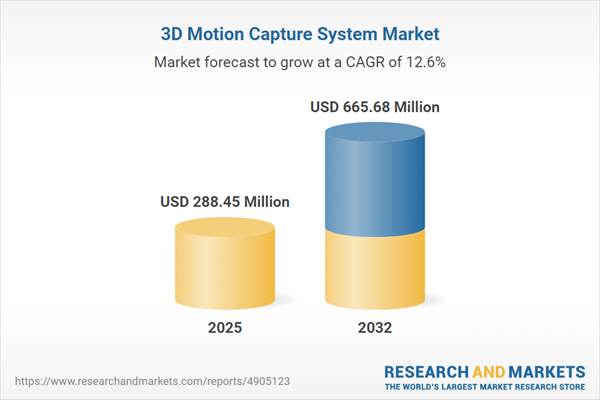Speak directly to the analyst to clarify any post sales queries you may have.
As digital transformation becomes essential for global enterprises, the 3D motion capture system market is attracting heightened interest among business leaders seeking operational agility, actionable data, and scalable innovation for complex environments.
Market Snapshot: 3D Motion Capture System Market Overview
The global 3D motion capture system market is advancing rapidly, with projections indicating strong revenue growth from USD 257.71 million in 2024 to USD 288.45 million in 2025, and reaching USD 665.68 million by 2032, marking a robust CAGR of 12.59%. Market momentum is fueled by enterprise demand across key sectors such as research, industrial automation, healthcare, and media production. Core drivers include the need for real-time process optimization and enhanced workflow efficiency. As adoption accelerates, organizations are achieving streamlined operations, improved adaptability, and greater capacity to navigate evolving industry challenges.
Scope & Segmentation of the 3D Motion Capture System Market
This research identifies the principal components, technologies, capture approaches, use cases, regional dynamics, and top vendors shaping the 3D motion capture system market for enterprise leaders:
- Components: Camera units, sensor arrays, marker kits, cables, mounting hardware, and calibration sets form the technological base of these systems. Services including installation, analytics, technical support, software maintenance, and data visualization support performance and enable continuous operational improvement.
- Technologies: Inertial tracking, relying on accelerometers, gyroscopes, and magnetometers, allows for flexible deployment models; optical and mechanical marker-based techniques deliver highly precise measurement—especially vital in sectors demanding uncompromised accuracy.
- Capture Methods: Marker-based workflows excel when high precision is required, while markerless systems offer easier adoption and lower ongoing maintenance complexity, supporting organizations prioritizing simplified integration.
- End-User Verticals: Research laboratories, healthcare institutions, robotics and automation, media and entertainment, and military training represent substantial application domains. Use cases range from interactive media product development and robotics programming to physical rehabilitation and advanced simulation.
- Regions: North America, Latin America, Europe, the Middle East, Africa, and Asia-Pacific each play a role, with enterprises considering regulatory compliance, local operational requirements, and regional partnerships crucial for successful deployment.
- Leading Companies: Industry innovation is driven by prominent players such as DEEPMOTION, Movella, A-Tech Instruments, Centroid 3D, DARI Motion, Motion Analysis, NANSENSE, Planar Systems, Noitom, NOKOV Science & Technology, Noraxon USA, Notch Interfaces, PhaseSpace, Polhemus, ProductionHUB, Prophysics AG, PTI Phoenix Technologies, Qualisys, Reallusion, Rokoko Studio, Sony Electronics, STT SYSTEMS, Synertial, Vicon Motion Systems, and Adobe. Their continued advancements and solution rollouts directly impact enterprise transformation strategies.
Key Takeaways for Senior Decision-Makers
- Sensor miniaturization and the movement toward markerless workflows enable enterprises to expand 3D motion capture deployments across distributed sites and keep pace with business changes.
- AI-enabled analytics provide more actionable insight, improving data interpretation and accelerating organizational decision-making, which is essential for business optimization and diagnostics.
- Cloud-based platforms enhance collaboration, bringing together teams across locations and helping maintain project momentum despite geographic dispersion.
- Integrated hardware and software offerings, coupled with comprehensive vendor support, lower implementation risks for organizations scaling up or restructuring digital capabilities.
- Applications extend from diagnostics and rehabilitation to sports science, immersive simulation, and media content creation, enabling organizations to innovate and meet the evolving needs of advanced sectors.
- User-focused onboarding and intuitive interfaces speed up adoption and mitigate the transition risks associated with enterprise-wide technology integration.
Tariff Impact: U.S. Tariff Adjustments and Hardware Supply Chains
Recent changes to U.S. tariffs on 3D motion capture hardware are driving enterprises to reassess sourcing and production strategies. Many are adapting by moving toward nearshoring and regional production to sustain supply chain resilience and quickly address changing regulatory conditions.
Methodology & Data Sources
This analysis is produced through executive interviews, product demonstrations, and collaboration with technology stakeholders. Validation is anchored in regulatory filings, technical documents, patent reviews, and reconciliation with academic and industry datasets to deliver actionable intelligence for enterprise stakeholders.
Why This Report Matters
- Enables senior leaders to benchmark and prioritize digital initiatives, ensuring investments are strategically aligned with operational objectives.
- Offers forward-looking insight on supply chain risks and regulatory shifts, preparing organizations to proactively manage disruption.
- Highlights critical advances in automation and analytics to support decision-making and drive consistent long-term competitiveness.
Conclusion
This report provides senior executives with reliable, actionable insight for integrating 3D motion capture systems, supporting agile strategy development and impactful enterprise digital transformation.
Additional Product Information:
- Purchase of this report includes 1 year online access with quarterly updates.
- This report can be updated on request. Please contact our Customer Experience team using the Ask a Question widget on our website.
Table of Contents
3. Executive Summary
4. Market Overview
7. Cumulative Impact of Artificial Intelligence 2025
List of Figures
Companies Mentioned
The companies profiled in this 3D Motion Capture System market report include:- DEEPMOTION, INC. by Xiaomi Corporation
- Movella Inc.
- A-Tech Instruments Ltd.
- Centroid 3D
- DARI Motion, Inc. by Scientific Analytics Inc.
- Motion Analysis Inc.
- NANSENSE Inc.
- Planar Systems, Inc.
- Noitom Ltd.
- NOKOV Science & Technology Co., Ltd.
- Noraxon USA, Inc.
- Notch Interfaces Inc.
- PhaseSpace Inc.
- Polhemus
- ProductionHUB, Inc.
- Prophysics AG
- PTI Phoenix Technologies Inc.
- Qualisys AB
- Reallusion Inc.
- Rokoko Studio
- Sony Electronics Inc.
- STT SYSTEMS
- Synertial
- Vicon Motion Systems Ltd
- Adobe Inc.
Table Information
| Report Attribute | Details |
|---|---|
| No. of Pages | 194 |
| Published | November 2025 |
| Forecast Period | 2025 - 2032 |
| Estimated Market Value ( USD | $ 288.45 Million |
| Forecasted Market Value ( USD | $ 665.68 Million |
| Compound Annual Growth Rate | 12.5% |
| Regions Covered | Global |
| No. of Companies Mentioned | 26 |









